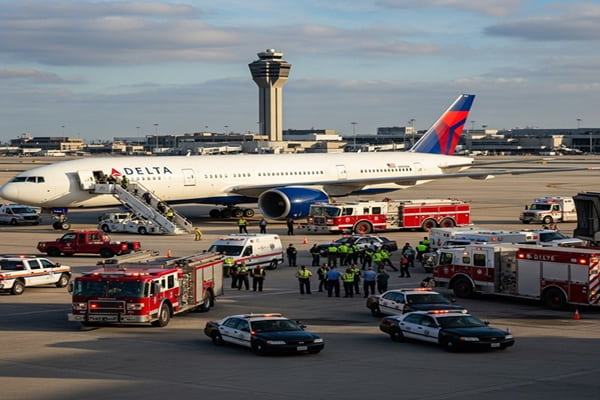When you think of air travel emergencies, your mind probably jumps straight to worst-case scenarios. But sometimes, what looks like a dramatic “emergency landing” is actually the result of calm, professional decision-making designed to keep everyone safe. That’s exactly what happened on May 27–28, 2025, when Delta Flight DL275 from Detroit (DTW) to Tokyo (HND) had to divert to Los Angeles International Airport (LAX) after a mid-flight technical issue.
Far from being a crisis, the incident became a textbook example of aviation safety, teamwork, and preparedness. Let’s break down what happened, why it mattered, and what lessons the airline industry—and passengers like you—can take away from it.
What Went Wrong: The Technical Glitch at 38,000 Feet
The trouble started about five hours into the flight, cruising at roughly 38,000 feet over the Bering Sea. The aircraft, an Airbus A350-900 powered by Rolls-Royce Trent XWB engines, flagged a problem with its anti-ice system.
Why does this system matter?
-
Jet engines are vulnerable to ice buildup at high altitudes, especially over remote, cold oceanic regions.
-
The anti-ice system prevents dangerous ice accumulation on engine parts.
-
While the fault wasn’t immediately life-threatening, flying for hours over the Pacific without this protection was too risky.
In short, the plane was perfectly flyable—but continuing across the Pacific toward Tokyo wasn’t worth the gamble.
Flight Timeline: From Detroit to Los Angeles
Here’s a clear look at how the day unfolded:
-
Departure (DTW): 3:53 PM EDT, May 27, slightly delayed due to a late inbound aircraft.
-
Cruising phase: Roughly five hours in, the crew noticed the anti-ice fault alert.
-
Diversion decision: Pilots coordinated quickly with Delta operations and air traffic control (ATC).
-
Landing (LAX): Touched down safely at 1:08 AM PDT, May 28, on Runway 06R.
-
Total flight time: Around 12 hours and 15 minutes, Detroit to Los Angeles.
Instead of Tokyo, passengers ended up in LA—but safe and sound.
Behind the Scenes: Crew, Passengers, and Operations
Flight Crew Response
-
Pilots stayed calm, assessing the risk and choosing LAX for its strong Delta hub infrastructure.
-
The cabin crew reassured passengers, making sure communication was clear and panic never spread.
Passenger Experience
-
No injuries or major medical events were reported.
-
Upon arrival, Delta arranged hotel rooms, meals, and rebookings for passengers headed to Tokyo.
-
Support staff helped manage the chaos that comes with international diversions.
Aircraft Maintenance
-
The A350 stayed grounded for about 18 hours.
-
Delta’s maintenance team and Rolls-Royce specialists conducted a full inspection before returning it to service.
The Financial Cost of the Diversion
Airline diversions aren’t just logistical headaches—they’re expensive. Analysts estimate this incident cost Delta around $2.3 million directly, covering:
-
Extra fuel from rerouting
-
Landing and crew fees at LAX
-
Hotels and meals for passengers
-
Cancelled onward flight to Tokyo and ripple effects across the network
When factoring in potential long-term passenger revenue loss, some reports suggested the total impact could creep closer to $5.9 million.
What This Incident Teaches Us About Aviation Safety
Even though this wasn’t a “near-disaster,” it carries some big lessons for both the industry and passengers.
1. Predictive Maintenance and AI Could Prevent Diversions
-
Modern aircraft generate huge amounts of data.
-
AI-powered predictive maintenance tools could have detected this anti-ice issue hours before departure.
-
Airlines that invest in these systems are already cutting unplanned maintenance costs and avoiding expensive diversions.
2. Situational Awareness Saves Lives
-
The pilots’ decision to choose LAX instead of Anchorage or Seattle wasn’t random.
-
While those airports were geographically closer, only LAX had the right mix of Delta hub operations, A350 support, and Rolls-Royce technicians.
3. Communication Shapes Passenger Trust
-
Clear, calm updates from the crew kept passengers at ease.
-
After landing, Delta’s quick action with accommodations and rebookings turned a stressful disruption into a story of professionalism.
-
This shows how customer care in crisis builds long-term loyalty.
4. Emergency Preparedness is Priceless
Every safe diversion proves the system works: layers of monitoring, pilot training, maintenance crews, and airport readiness all come together.
Also Read : Understanding Gärningen: Meaning, Importance, and Impact
FAQs About Delta Flight DL275’s Diversion
Q1: Why was the flight diverted to LAX?
Because of a malfunction in the engine’s anti-ice system. LAX was chosen for its technical capability, not just its location.
Q2: Were passengers hurt?
No. Everyone landed safely, and Delta provided care and rebookings.
Q3: How long was the total flight?
Roughly 12 hours and 15 minutes, including the diversion.
Q4: What caused the fault?
A failure in the Rolls-Royce Trent XWB engine’s anti-ice system.
Q5: Could AI have prevented this?
Possibly, yes. Experts believe predictive AI diagnostics might have flagged the issue before departure.
Q6: Why not divert to Anchorage or Seattle instead?
Those airports lacked the specialized maintenance support and infrastructure LAX provided.
Big Picture: Why This Story Matters
At first glance, the Delta Flight DL275 diversion might seem like a hassle—missed connections, unexpected hotel stays, and an expensive headache for the airline. But in reality, it’s a reminder of what makes modern aviation so safe.
-
Passenger safety always comes first, even if it means costly detours.
-
Technology and predictive tools will likely reduce incidents like this in the future.
-
Professionalism under pressure—from pilots to crew to ground staff—turned what could have been a panic-inducing event into just another story of aviation safety done right.
Final Thoughts
The Delta Flight DL275 diversion to LAX wasn’t a disaster story—it was a success story. Faced with a technical fault in a remote part of the world, the crew made the right call: protect lives, reroute wisely, and land safely.
Yes, the disruption came with a multi-million-dollar price tag, but it also highlighted how well the system works. For future passengers, the lesson is simple: sometimes a smooth landing requires a detour—and that’s perfectly okay when it means safety over shortcuts.
